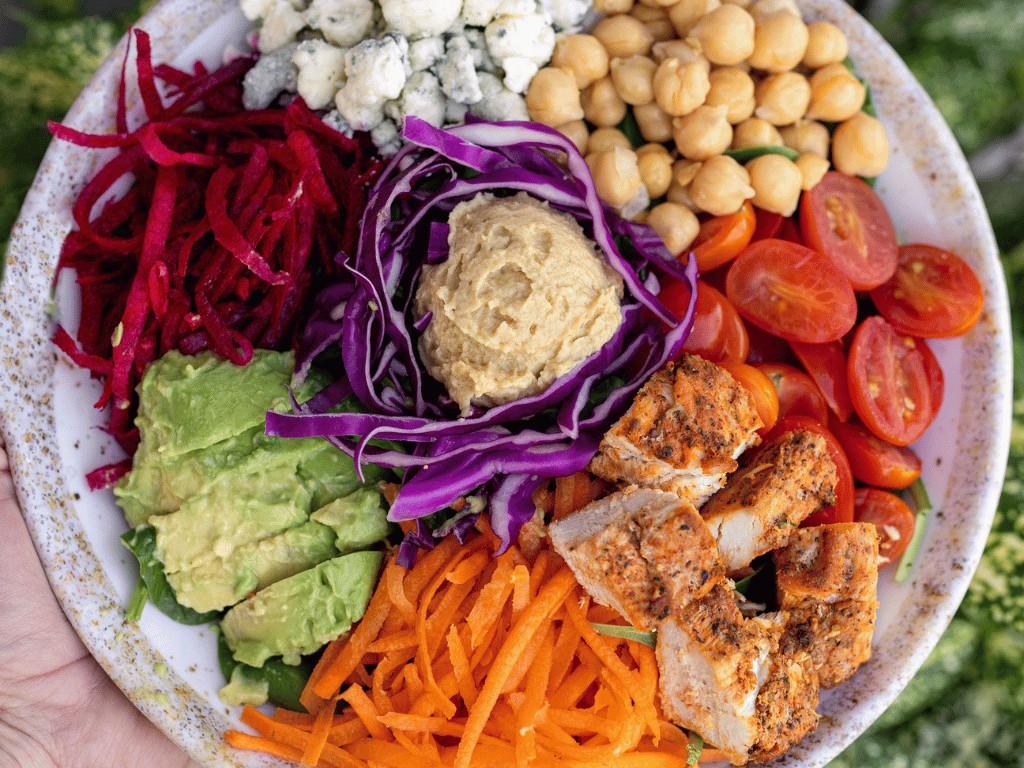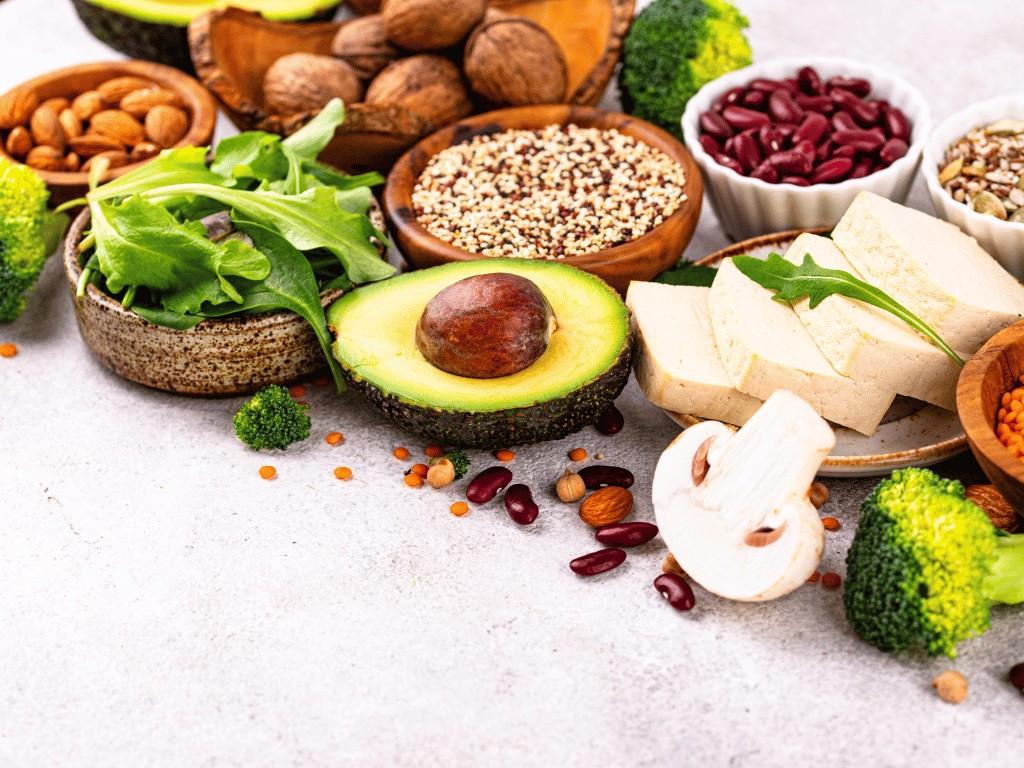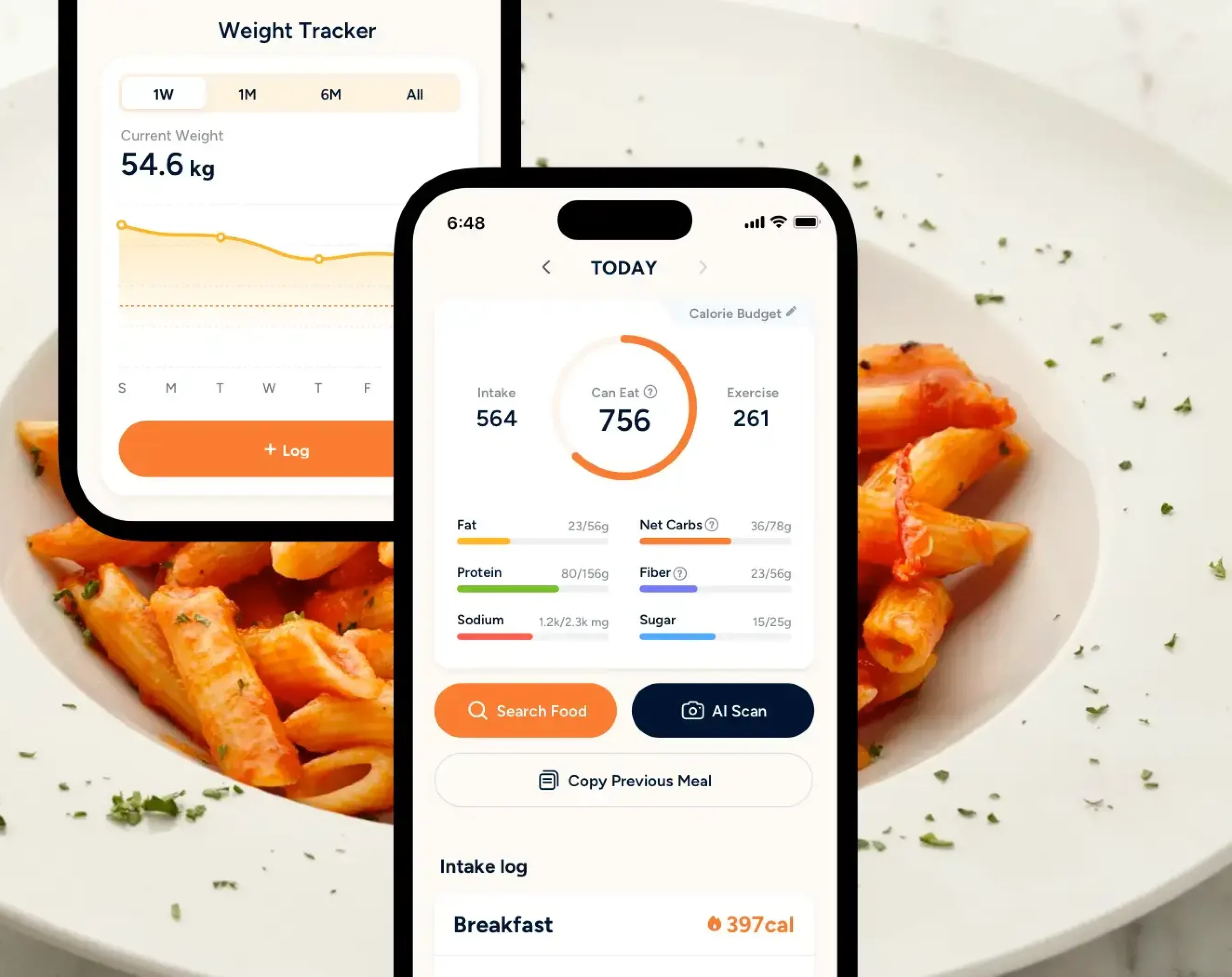If you’ve been searching for a diet to follow, you’ve likely come across the low FODMAP diet listed alongside popular plans like PCOS diet, keto, paleo, and intermittent fasting.
While many of these diets are considered to be fad diets, the FODMAP diet is an exception. It’s a scientifically backed approach, often prescribed to help individuals dealing with irritable bowel syndrome (IBS). This article serves as an introduction to everything you need to know about the low FODMAP diet.
Key Takeaways
- Unlike many fad diets, it’s a scientifically supported approach designed to help individuals with irritable bowel syndrome reduce symptoms like bloating, cramping, diarrhea, and constipation.
- The diet focuses on avoiding high FODMAP foods (like certain fruits, vegetables, dairy, legumes, and sweeteners) that ferment in the gut and cause gastrointestinal discomfort.
- The diet involves an elimination phase (2–6 weeks), a gradual reintroduction phase (8–12 weeks) to identify trigger foods, and a maintenance phase for long-term symptom management.
- You can expect to consume nutrient-rich options such as lean meats, fish, eggs, tofu, dairy alternatives, low FODMAP fruits and vegetables, whole grains, nuts, seeds, and healthy fats.
What is FODMAP?
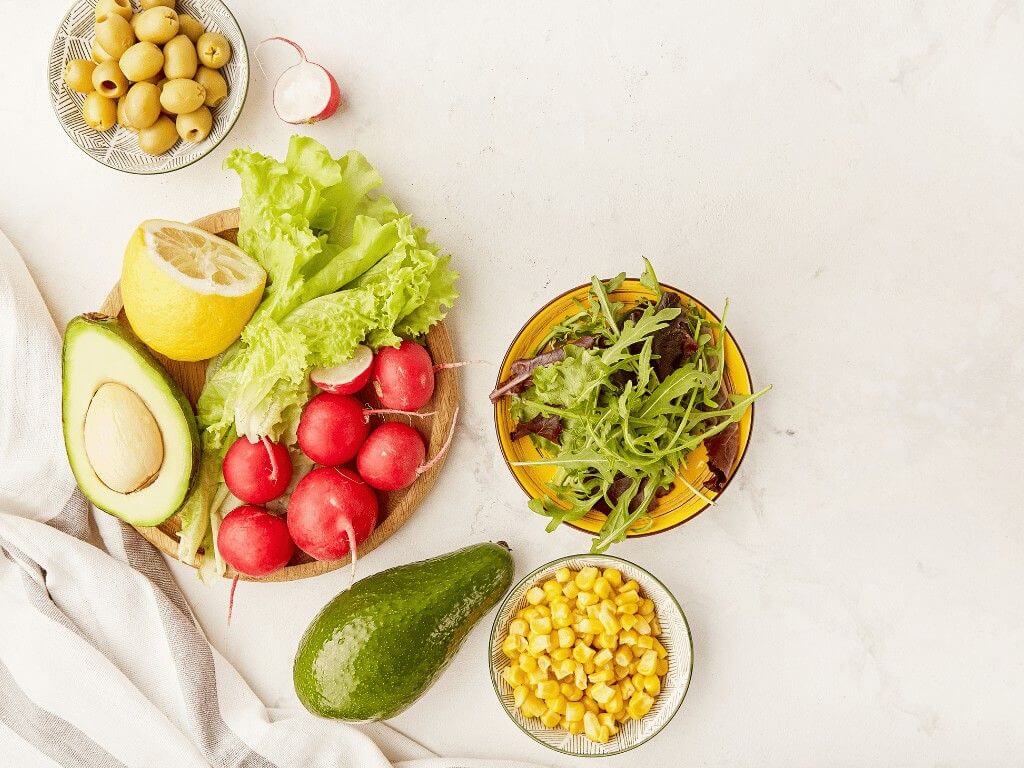
FODMAP is a classification term for a group of fermentable short-chain carbohydrates [1].
The acronym stands for:
- Fermentable
- Oligosaccharides
- Disaccharides
- Monosaccharides
- And
- Polyols
These carbohydrates are associated with the worsening of gastrointestinal symptoms such as cramping, bloating, and diarrhea. It tends to affect those with a very sensitive GI system or individuals with irritable bowel syndrome, a chronic gastrointestinal condition characterized by symptoms of abdominal pain, bloating, constipation, and/or diarrhea [2].
What is a Low FODMAP Diet?
A low FODMAP diet is a dietary approach that is meant to help those with irritable bowel syndrome (IBS). It was created as a way for those suffering to manage their symptoms by focusing on foods with low FODMAPs and avoiding foods high in FODMAPS, namely foods that include fermentable oligosaccharides, disaccharides, monosaccharides, and polyols.
It’s worth noting that while all FODMAPs can trigger digestive symptoms such as bloating and diarrhea, the purpose of a low FODMAP diet is to reduce the occurrence of these symptoms.
Benefits of the Low FODMAP Diet
The main benefits of adopting this diet approach [3] :
1. Reduces digestive symptoms
The most well-documented benefit by far is its ability to relieve IBS symptoms like bloating and diarrhea. Removing high trigger foods will help to improve digestion and absorption, as the gut has less to ferment.
2. Identifies personal triggers
Some foods can cause a higher degree of pain or discomfort to people suffering from IBS, and those types of foods are known as “trigger foods”. The idea behind being able to identify these trigger foods allows the individual to eliminate and eventually reintroduce these foods during the reintroduction phase.
3. Improves quality of life
By keeping your symptoms in check, you are likely to see an increase in energy levels, better sleep quality, and less stress or anxiety about eating.
4. Well-researched and clinically backed
This diet approach has been researched extensively for IBS patients. Monash University, in particular, has conducted significant studies on its benefits for digestive health [4].
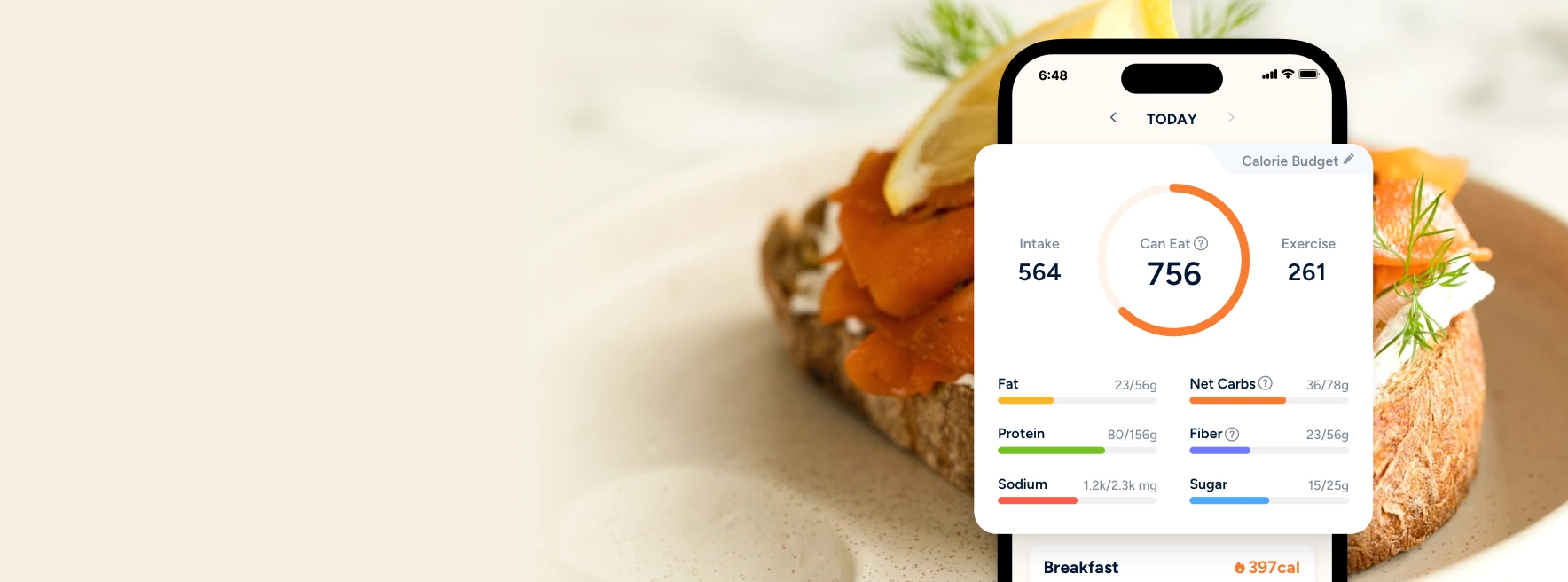
Smarter Nutrition Tracking
Track calories and over 100 other nutrients all in one place.
Download Eato For FreeHow To Get Started on the Low FODMAP Diet
As a beginner, you’ll need to know that there are 3 steps to following this diet.
Step 1: Elimination Phase
The first step is to follow an elimination diet. This means eliminating high FODMAP foods from your diet and focusing on eating low FODMAP alternatives. This phase will last between 2-6 weeks.
When your symptoms start to improve after a few weeks, you can then move on to step 2, or the reintroduction phase.
Step 2: Reintroduction Phase
In this phase, you can start to reintroduce high FODMAP foods back into your diet. This should be done over a period of 8 to 12 weeks.
During this period, you are highly encouraged to start reintroducing one food that is rich in one FODMAP group daily for 3 days and monitor for any adverse symptoms. You may also try to increase the portion size and see how well you tolerate it.
Step 3: Maintenance Phase
After going through steps 1 and 2, you should be able to identify what foods trigger symptoms and what don’t. The next step is to adopt a balanced diet by sticking to low FODMAP and high FODMAP foods that you tolerate well. Poor-tolerated foods and FODMAPs should continue to be restricted if they help with symptom relief.
The goal is to adopt a more relaxed diet and live a better quality of life. In general, diets that are too restrictive are not sustainable for the long term, as they can be hard to maintain and adapt to changing life situations.
While you move towards the reintroduction and maintenance phase of the diet, continue keeping track of the list of foods your body can tolerate, as well as those foods that trigger you. You should do this by identifying food labels, logging meals to stay organised, and you can do this all with the Eato app.
What Can You Eat on a Low FODMAP Diet?
Being on a low FODMAP diet does not mean that the foods you eat have to be unhealthy or unflavorful. In fact, there’s still a wide variety of delicious and nutrient-rich foods that you can incorporate as part of your meals.
List of low FODMAP foods
Here’s a list of low FODMAP foods to eat:
Meat and poultry: For low FODMAP meat and poultry, some options are beef, chicken, turkey, chorizo, pork, lamb, and Quorn meat substitute.
Fish and seafood: Low FODMAP fish and seafood options include fresh fish like cod, tuna, salmon, trout, crab, lobster, oyster, mussel, prawn, and shrimp.
Grains and carbohydrates: For grains and carbohydrates, you can opt for brown rice, oats, millet, quinoa, wheat-free bread, plain crackers, nuts and seeds, rice bran, tortilla chips, and corn flour.
Fruits: Low FODMAP fruits include applesauce, banana, strawberry, blueberry, cantaloupe, grapefruit, kiwi, lemon, limes, coconut, papaya, and orange.
Vegetables and legumes: For low FODMAP vegetables, some of the good options are kale, lettuce, potatoes, broccoli florets, Brussels sprouts, cucumber, eggplant, green beans, pumpkin, radish, and tomato.
Dairy foods and eggs: butter, margarine, cheese, eggs, tofu, tempeh, and Greek yogurt.
Dairy alternatives: Dairy-free alternatives include almond milk, lactose-free milk, oat milk, rice milk, macadamia milk, coconut milk, and lactose-free yogurt.
Fats, Oils & Condiments: Olive oil, coconut oil, avocado oil, sunflower oil, cacao powder, black pepper, mustard seeds, fenugreek, cilantro, cumin, paprika, cinnamon, and turmeric.
Snacks: For low FODMAP snacks, some options are plain popcorn, rice cakes, almond butter, macadamia nuts, peanut butter, aspartame, chocolate (in moderation), rice malt syrup, and stevia.
High FODMAP foods to avoid
Here’s a list of high FODMAP foods that you should avoid while on a low FODMAP diet:
Meats and seafood: Processed meats such as sausages with garlic or onion, Deli meats, Meatballs or meatloaf with breadcrumbs, onion, or garlic, canned fish with garlic or onion.
Vegetables: Onion (all types, incl. powder), garlic (incl. garlic powder), cauliflower, broccoli (especially stalks), cabbage, shiitake mushroom, portobello mushroom, asparagus, leeks, and artichokes.
Fruits: Apples, pears, watermelon, mango, cherries, peaches, plums, nectarines, apricots, dates, figs, dried fruit, and canned fruit.
Dairy: Cow milk, goat milk, sheep milk, ricotta cheese, cream cheese, cottage cheese, ice cream, regular yogurt, custards, and cream-based desserts.
Grains and carbohydrates: Barley, rye, wheat, nuts like cashews and pistachios, cereal bars, cookies, and cakes.
Legumes: Chickpeas, kidney beans, black beans, baked beans, and soybeans.
Sweeteners & Additives: High-fructose corn syrup, sorbitol, honey, mannitol, xylitol, and maltitol (found in many sugar-free gums)
Drinks: fruit juice, soda, beer, wine, rum, kombucha, sports drink, and energy drinks.

Smarter Nutrition Tracking
Track calories and over 100 other nutrients all in one place.
Download Eato For FreeLow FODMAP Diet Chart with Free PDF
In addition to the food list, we’ve also created a diet chart that has been created, featuring an extensive list of high and low FODMAP foods to eat or avoid.
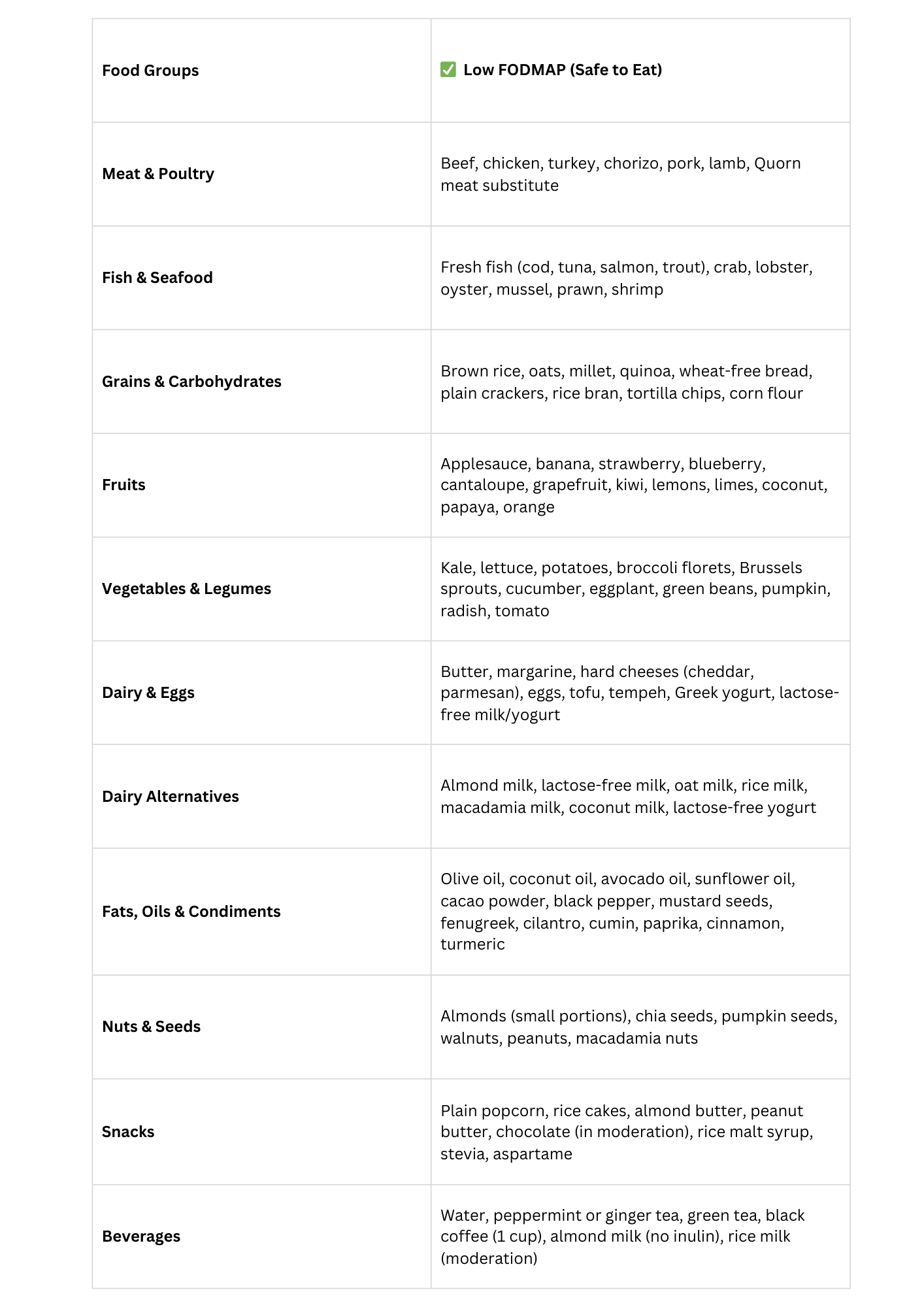
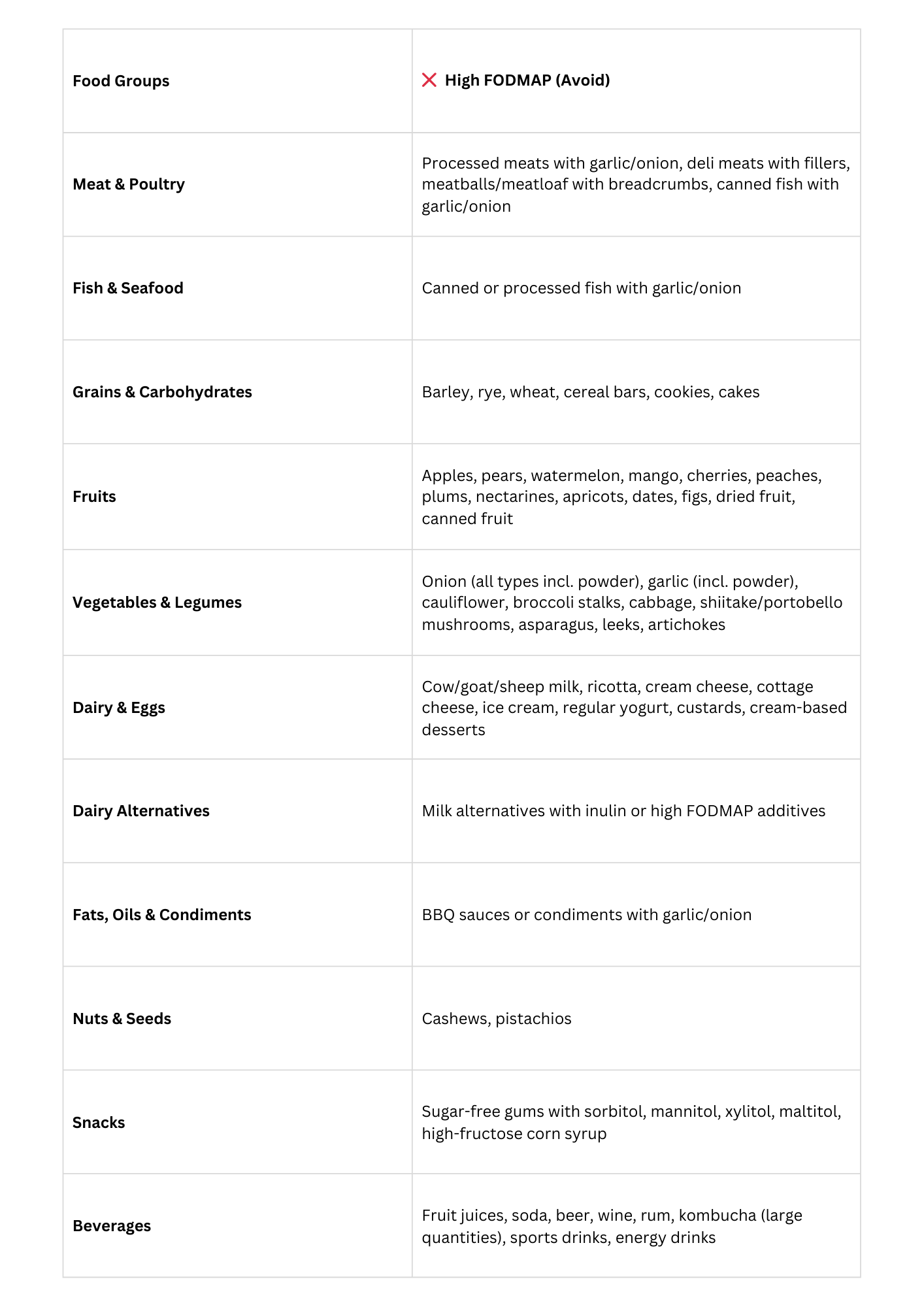
Example of a Low FODMAP Diet Plan
Now that you’re aware of what foods you can or cannot eat on a low FODMAP diet, the next thing to do would be to come up with a meal plan or a meal schedule over the course of a few weeks.
An example of what a 7-Day Low FODMAP meal plan may look like:
Day 1:
- Breakfast: Oatmeal with blueberries and almond milk
- Lunch: Grilled chicken salad with mixed greens, carrots, and olive oil dressing
- Dinner: Baked salmon with roasted zucchini and rice
- Snack: Rice cakes with peanut butter
Day 2:
- Breakfast: Scrambled eggs with spinach and gluten-free toast
- Lunch: Quinoa bowl with grilled chicken, bell peppers, and cucumber
- Dinner: Beef stir-fry with bok choy and rice noodles
- Snack: Handful of almonds (10 nuts)
Day 3:
- Breakfast: Smoothie with banana, spinach, and lactose-free milk
- Lunch: Tuna salad lettuce wraps with tomatoes
- Dinner: Grilled pork chops with sweet potato and green beans
- Snack: Strawberries with lactose-free yogurt
Day 4
- Breakfast: Rice cereal with sliced banana and rice milk
- Lunch: Chicken and vegetable soup (low FODMAP vegetables)
- Dinner: Baked cod with roasted carrots and quinoa
- Snack: Orange slices
Day 5
- Breakfast: Gluten-free pancakes with maple syrup and berries
- Lunch: Turkey and cheese wrap (corn tortilla)
- Dinner: Tofu stir-fry with permitted vegetables and rice
- Snack: Rice crackers with cheese
Day 6
- Breakfast: Chia seed pudding with almond milk and kiwi
- Lunch: Grilled chicken with quinoa salad
- Dinner: Lamb chops with roasted eggplant and potatoes
- Snack: Grapes
Day 7
- Breakfast: Omelet with allowed vegetables and herbs
- Lunch: Salmon salad with mixed greens
- Dinner: Chicken curry (garlic-free) with rice
- Snack: Pineapple chunks
5 Low FODMAP Diet Recipes to Try
Being on a low FODMAP diet doesn’t mean your meals have to be boring or restrictive. Here are 5, easy and delicious recipes to try:
1. Grilled Lemon Herb Chicken with Quinoa
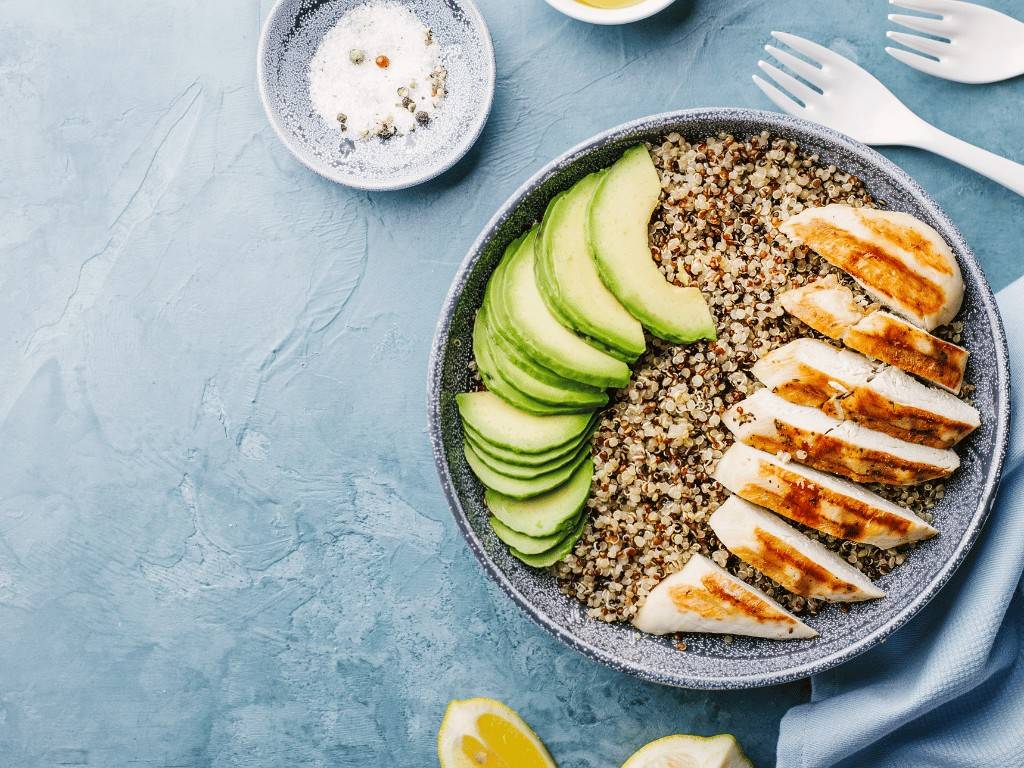
Ingredients:
- 2 boneless chicken breasts
- 2 tbsp olive oil
- Juice of 1 lemon
- 1 tsp dried thyme
- 1 tsp dried rosemary
- Salt & pepper to taste
- 1 cup cooked quinoa
- 1 cup steamed spinach
Instructions:
- In a bowl, mix olive oil, lemon juice, thyme, rosemary, salt, and pepper.
- Marinate chicken in the mixture for at least 30 minutes.
- Grill or pan-sear chicken over medium heat for 5–7 minutes on each side or until fully cooked.
- Serve with cooked quinoa and steamed spinach.
2. Salmon with Roasted Pumpkin & Green Beans
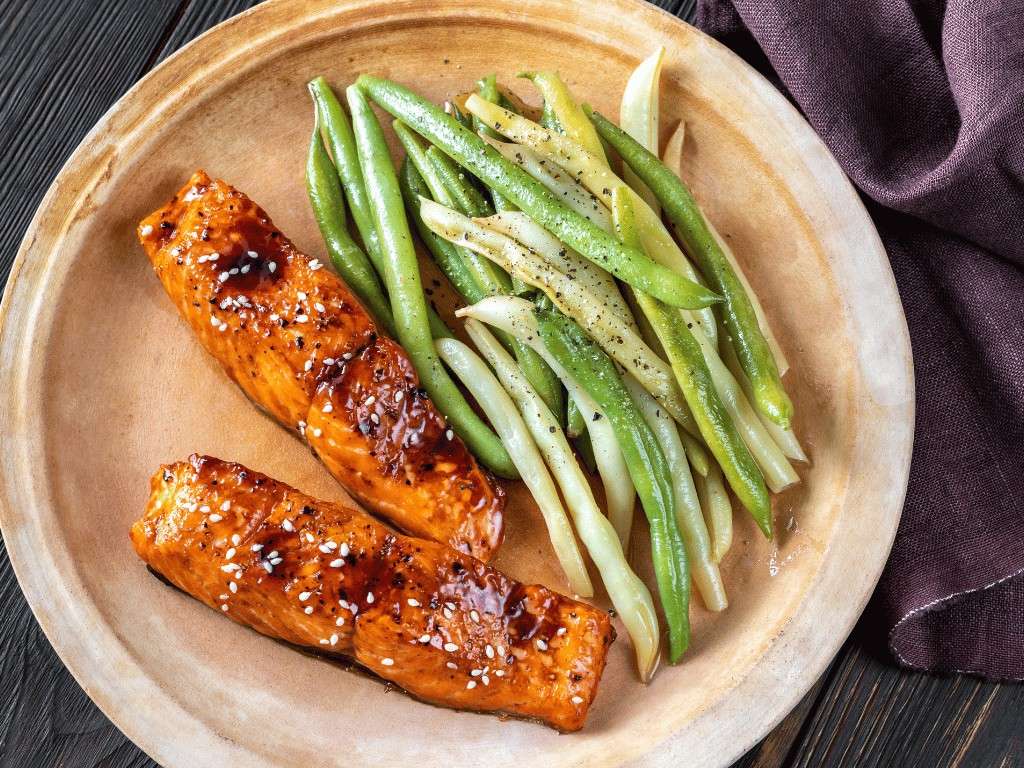
Ingredients:
- 1 salmon fillet
- 1 cup pumpkin, cubed
- 1 cup green beans, trimmed
- 1 tbsp olive oil
- Salt & pepper
Instructions:
- Preheat oven to 200°C (400°F).
- Toss pumpkin and green beans in olive oil, salt, and pepper.
- Spread veggies on a baking tray and roast for 25 minutes.
- Pan-sear the salmon on medium-high heat for 3–4 minutes per side.
- Plate salmon with roasted vegetables.
3. Zucchini & Carrot Fritters

Ingredients:
- 1 cup grated zucchini (squeezed dry)
- 1 cup grated carrot
- 2 eggs
- 2 tbsp rice flour
- 1/2 tsp cumin
- Salt & pepper
Instructions:
- Mix all ingredients in a bowl until combined.
- Heat a non-stick pan with a little olive oil.
- Drop spoonfuls of batter onto the pan and flatten.
- Cook 3–4 minutes per side until golden brown.
- Serve warm with a lactose-free yogurt dip (optional).
4. Banana & Blueberry Oatmeal
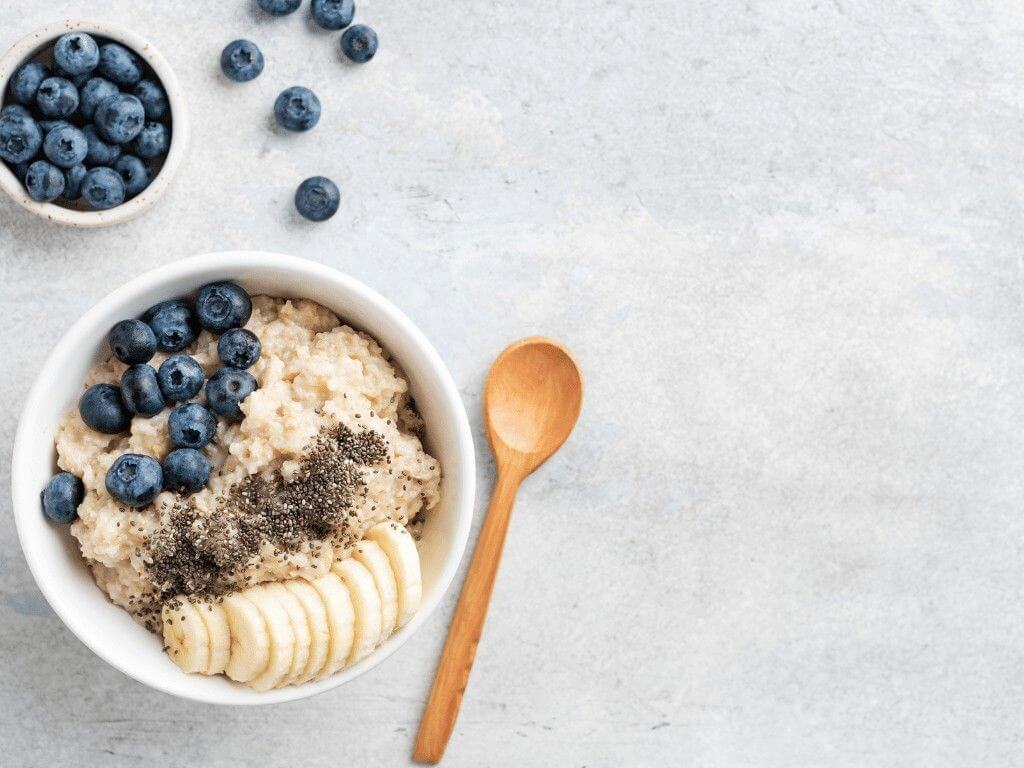
Ingredients:
- 1/2 cup rolled oats
- 1 cup almond or lactose-free milk
- 1/2 unripe banana, sliced
- 1/4 cup blueberries
- 1/2 tsp cinnamon
Instructions:
- Combine oats and milk in a small saucepan.
- Cook over medium heat, stirring until creamy (about 5 minutes).
- Stir in banana, blueberries, and cinnamon.
- Serve warm. You can top with a few chia seeds if desired.
5. Greek Yogurt with Strawberries & Chia Seeds

Ingredients:
- 1/2 cup lactose-free Greek yogurt
- 1/4 cup sliced strawberries
- 1 tsp chia seeds
- 1 tsp maple syrup (optional)
Instructions:
- Scoop yogurt into a bowl.
- Top with strawberries, chia seeds, and a drizzle of maple syrup.
- Enjoy immediately for a quick and healthy snack.
Final Takeaway: A Note on the Low FODMAP Diet
As we know it, the low FODMAP diet is a clinically backed approach that can potentially help individuals with IBS to manage and improve their symptoms. It is meant to be a systematic approach in helping you identify personal food triggers and follow a more nutritionally balanced diet for the long term.
By carefully monitoring your health and keeping track of what you eat, you should be able to navigate this journey successfully and sustainably. With intuitive food logging and personalized insights, the Eato app makes a great solution for helping you stay in control of your eating patterns. Start using Eato today to stop the guesswork. Try it for free!
Disclaimer: This article is only meant to provide a comprehensive introduction to the low FODMAP diet. Always consult with a healthcare provider or registered dietitian before making significant dietary changes, especially if you have underlying health conditions. The Low FODMAP diet should be implemented under professional guidance for optimal results and safety.

Smarter Nutrition Tracking
Track calories and over 100 other nutrients all in one place.
Download Eato For Free
